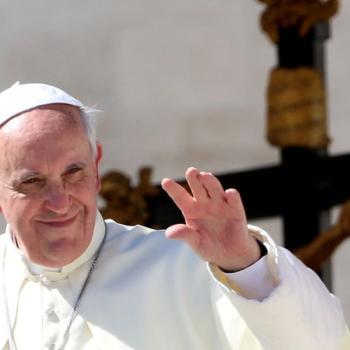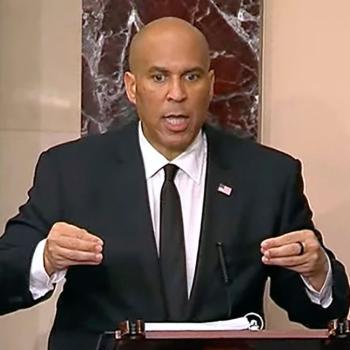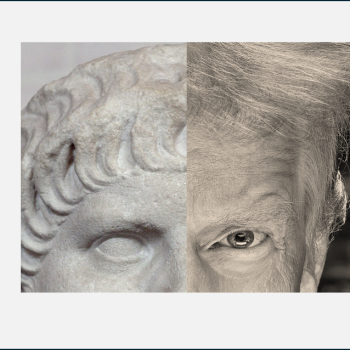Christian clergy speaking at protests have a unique role and opportunity to use their prophetic voice. Here are tips and advice.
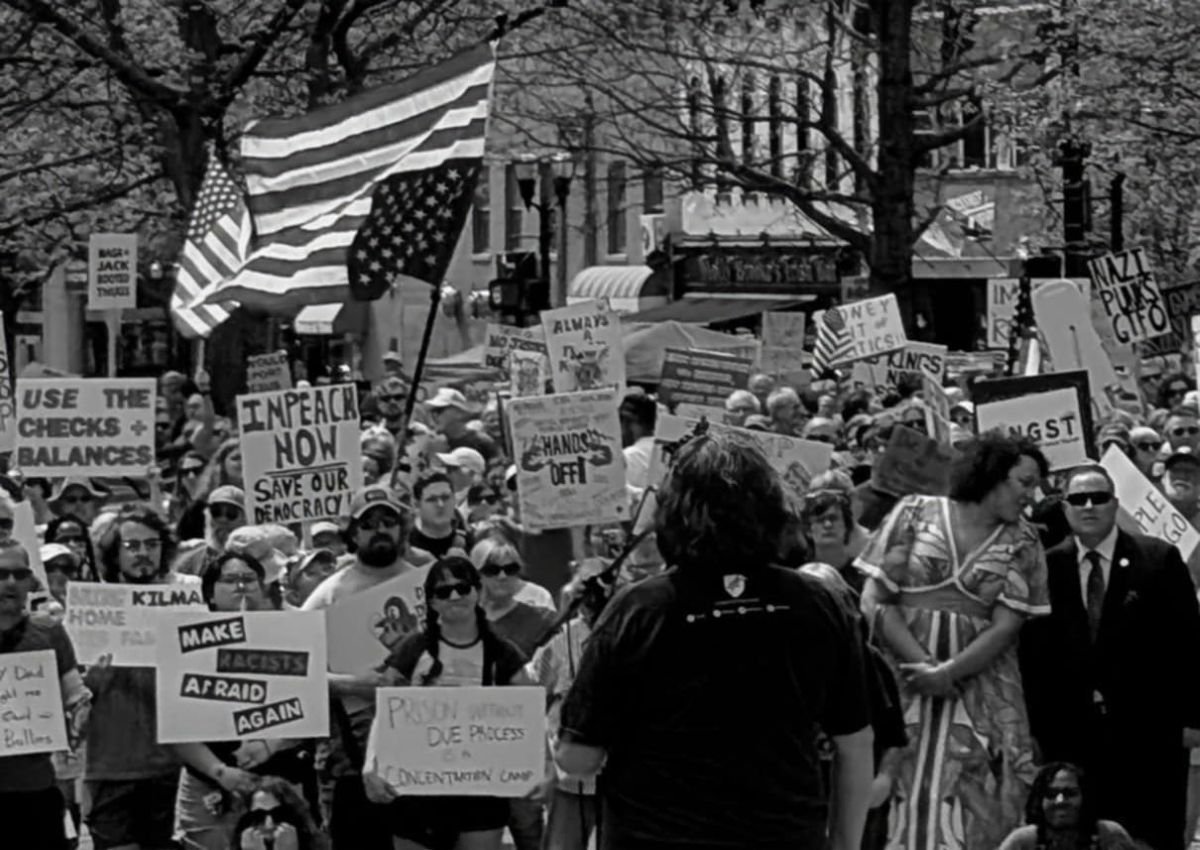
Co-written by Rev. Dr. Leah D. Schade and Rev. Amanda Groves
Since Inauguration Day 2025, Americans have been protesting the current presidential administration on a weekly basis. Some are smaller, local events; others have been nationwide demonstrations such as the “Hands Off,” “No Kings,” and “May Day” protests. For these kinds of public demonstrations, clergy are often called upon to offer an invocation, a speech, or a final blessing.
We’re both Christian ministers who have spoken multiple times at public protests and demonstrations over the past twenty years. So, if you are a Christian leader who has been invited to be a speaker at a protest, here are 13 tips to make your speech energizing, memorable, and meaningful.
1 – Know your audience and your topic.
People who have gathered for a demonstration took the time to make a protest sign, travel to a location, stand or march in all kinds of weather, and make their voices heard. They are exercising their First Amendment right for the freedom of speech and peaceable assembly to “petition the Government for redress of grievances.”
In other words, a public protest is not a church worship service.
This means that you’ll need to avoid theological aphorisms and religious insider language in your speech. At the same time, you are looked to as a trusted religious leader in the community whose voice adds moral clarity to the issue. So, research the topic, name and frame the issue from a faith perspective, and make your message accessible to a diverse audience.
2- Recognize that you’re in a multi-faith setting, but claim your role as a Christian clergyperson.
Public protests draw people from all walks of life and, depending on the context, many different religions. Also, some of the attendees will practice no religious or faith tradition at all.
So, when you pray, use general terms to refer to the Divine rather than addressing Jesus Christ. “God of many names,” “Creator of all,” and “In the name of all that is holy,” are appropriate terms to use.
At the same time, we recommend wearing the vestments of your office, such as a clerical collar, cross, stole, or alb. Not only does this give a visual reminder to the audience of your calling, but also reminds YOU of who you are and who you are representing.
Even if people (and politicians) do not hear your words, they will see that you represent the church and, even more, that you are bringing the witness of God’s Spirit into the public square. Your presence symbolizes the ethical values that expose the moral callousness of those who are harming the community.
3 – Don’t preach a sermon — deliver a succinct address.
Unless the public event is an actual worship service, refrain from preaching a sermon at a protest.
You can certainly use biblical passages, make theological claims, and use religious language in your speech (more on that below). But avoid long-winded exegesis, stories, illustrations, and didactic elements. Instead, keep your speech or prayer short, succinct, and engaging.
Most protest speeches are around 3-5 minutes in length, and it’s important to respect the time limits. For one, there are other speakers and they all deserve equal time. For another, people will get bored if you drone on. You don’t want the energy of the event to flag when you start to speak. Also, people’s attention spans are short.
So, follow the directions of the event organizer regarding the length of your speech; keep it tight and focused.
Also, keep in mind that the crowd may respond with cheers and applause, so you’ll want to keep that in mind regarding the timing of your speech. This is something that may come as a surprise to preachers who don’t experience communal responses during their sermons. You may want to watch sermons of African American preachers to learn how they build suspense and energy, engage their listeners, and respond to the reactions from the congregation. Once you’ve experienced this, you’ll see how exhilarating that kind of give-and-take can be!
4 – Know your place in the line-up.
If you are scheduled to pray or speak at the beginning, you’re setting the tone for the whole rally. If you are giving a speech in the middle of the event, attention may have wandered after so many speakers, so you need to regain their eyes and ears and give the rally a boost with your speech.
And if you’re scheduled for the end, the crowd may be getting restless. In this case, your speech or prayer should pump them up and send them out energized for the next steps in their resistance.
5 – Utilize straightforward rhetoric and speech forms.
Protests are sometimes loud with many distractions, including honking traffic, shouts from counter-protesters, and general noise from the crowd. This means that your speech must be easy to follow with short sentences and uncomplicated syntax. Avoid run-on sentences and nuanced metaphors. Instead, use images that are easy to grasp and employ forms that are straightforward.
Here are simple forms for a protest speech that people can easily follow.
Form 1:
Situation (what’s happening); Complication (why it’s wrong); Solution (what we must do in response)
Form 2:
Biblical premise; Violation by the administration; Call to action
Form 3:
Violation by administration; Biblical call-out; Appeal to community values
6 – Use repetition and call-and-response.
Repeating a certain word, phrase, or slogan is an effective way to keep your audience’s attention and create a sense of community and solidarity. We are still repeating some of Jesus’s “slogans” 2000 years later, such as “Faith like a mustard seed,” “Turn the other cheek,” “The first shall be last, the last shall be first.”
So, employ a catch phrase that is easy to repeat and remember so that the audience can track with you, and even repeat with a call-and-response.
Protests often use call-and-response to engage the crowd and make loud, public acclamations. Call: Show me what democracy looks like! Response: This is what democracy looks like!
Clergy can utilize this same rhetorical technique in their protest speech. For example, in this clip from Amanda’s speech at the Hands Off Rally in Paducah, Kentucky, she had the audience repeat the phrase, “That is wrong!” and then had them repeat that during her litany of wrongs committed by the administration.
So, if you’re introducing a call-and-response that is new, cue the audience and have them practice once. Then fire them up and build their energy by repeating that shared phrase or response. Remember that you are giving voice to their concerns, so when they join you in repetitions and call-and-response, everyone is able to raise their voices together.
7 – Use a prop or dramatic action if appropriate.
Some of the Hebrew prophets used props, dramatic actions, and even street theatre to get their message across to the people and the rulers. For example, Jeremiah wore an ox yoke to warn about Israel’s submission to Babylon (Jer. 27:1-22). To announce about the coming Babylonian siege, Ezekiel symbolically cut his hair and beard and proceeded to burn, strike, and scatter the hair (Ez. 5:1-4).
Also, Jesus was famous for his demonstrations against corrupt power, such as riding a donkey into Jerusalem (Matt. 21:1-11) and overturning the merchants’ tables in the temple (Mark 11:15-17).
In this speech that Leah gave at a 2011 anti-fracking rally in Philadelphia, she held a cloth with a water pattern to symbolize the sacredness of water. At the end of the speech, Rabbi Melissa Klein blows a shofar, a ram’s horn, as a symbolic act of waking people up to the need for justice in the face of the shale gas industry. You can watch the clip here.
Clergy who speak at protests can also use props and dramatic symbolic actions. Be sure the prop or action is big enough to be seen from a distance and has an obvious connection to the issue.
8 – Appeal to cherished ethics and values.
One of the most important functions of the religious voice at a protest is to provide moral and ethical framing based on long-established values. Especially in the U.S. where Christian theology and the Bible are being hijacked and twisted to serve the agenda of cruel and violent nationalism, clergy must call out this heresy and unequivocally proclaim the heart of Christianity.
That heart is built from compassion, justice for the oppressed, protection of the vulnerable, adherence to an ethical code, and restoration of what has been broken. So, be sure to name those values in your speech. Also, make it clear that these are not partisan or blue/red values; rather, they are the will of God for how we are to live.
9 – Choose well-known, pithy biblical passages and themes.
A protest speech is not the time to explain the Hebrew or Greek origins of a key word in a biblical text. Nor is it appropriate to show off your skills in historical-critical exegesis. Instead, pick short, well-known passages and themes that will resonate with the crowd. Here are some suggestions:
- Love your neighbor (Mark 12:31)
- Care for the vulnerable (Matt. 25:45)
- Have mercy on and assist those who are hurting (Luke 10:25-37, the Good Samaritan)
- Welcome the stranger (Lev. 19:34, Heb. 13:2)
- Defend the weak (Psalm 82:3, Luke 4:18)
Below is a picture of Leah using the theme of loving our neighbors as the basis of ensuring due process for all. Appealing to the authority of Scripture based on universal values will ground your speech in time-honored principles and appeal to a broad audience.
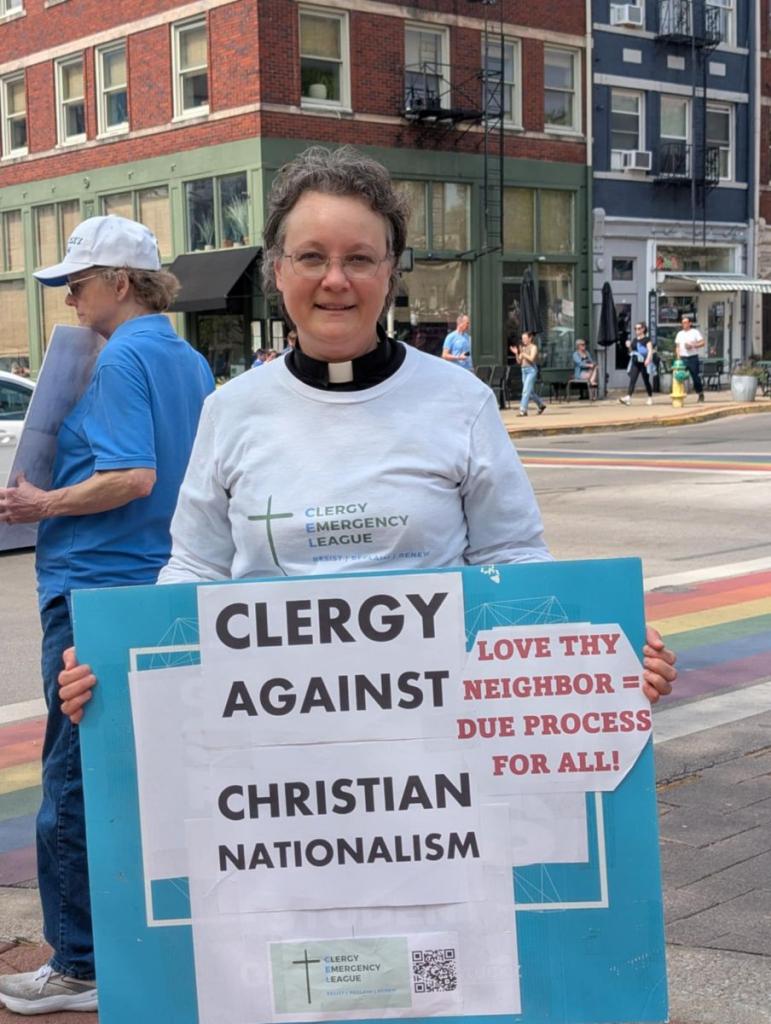
10 – Use your “outside voice” and deliver with impact.
The amplification used for speeches at a demonstration can range from a bullhorn to a microphone and speakers to the mere projection of your own voice. Regardless of the type (or lack of) amplification used, your prayer or speech should be delivered with your “outside voice.” In other words, project loudly, enunciate your words, and speak at a pace that people can follow.
Rhythm, pitch, and dramatic pauses are also important. Especially when using a repeated phrase or call-and-response, use your voice to cue the audience when to respond. Learn how to speed up and slow down when necessary, raise and lower the pitch of your voice, and insert brief pauses for effect. This will catch the listeners’ attention and keep them with you.
11 – Consider your tone or “vibe.”
What is the mood you want to project in this speech? Righteous anger? Upbeat encouragement? Caustic critique? Rousing call to action? Maybe a combination of these?
Choosing the tone for your speech will depend on the subject and the purpose you intend. For example, Amanda’s tone in her Hands Off speech is one of righteous anger. She begins by explaining how God honors diversity, equity, and inclusion despite efforts being made to rewrite history. Then she lowers her pitch and relaxes her stance to signal a new topic. She uses a personal experience to set up the message. After that, she deliberately takes a beat of silence to get the audience’s attention and then launches into the call and response. Notice that her cadence remains the same for each part of the litany so that the audience knows when to respond.
Whatever “vibe” you want to project, don’t be afraid to be dramatic and use all the performative skills in your preacher’s toolbox. And most importantly, be authentic! Speaking from the heart and being genuine with your emotions will draw your listeners to your message and galvanize them to right the wrongs you name.
12 – Practice, practice, practice
Even a brief three-minute speech requires practice. Try to memorize your speech if possible. If you must use notes, having them in a spiral notebook will keep the pages from flying in the wind. Minimize page turns and use large print. Also, do not read your manuscript; make eye contact with the crowd and deliver your speech with gusto!
13 – “Count the cost” (recognize the risk)
On April 28, 2025, Rev. Dr. William Barber and two other clergy were arrested in the Capitol Rotunda in Washington D.C. for their “pray in” against the Republican budget that would hurt the poor while further enriching billionaires.
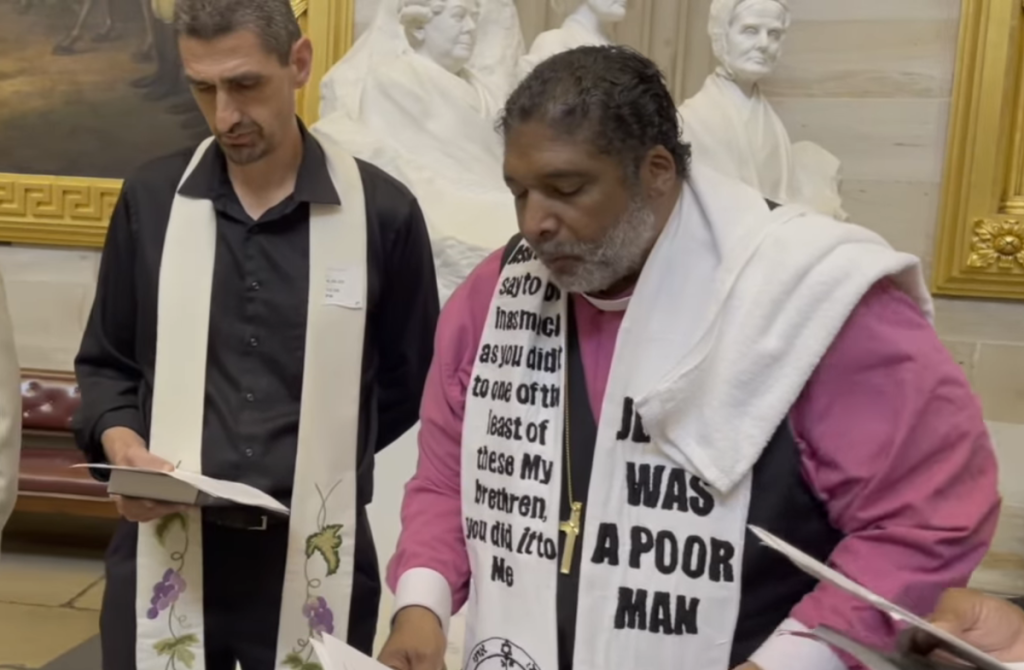
In this video, Rev. Barber can be heard praying, “We are here crying to you, O God, because we’ve heard the cries of your people.” Rev. Jonathan Wilson-Hartgrove then notes that the budget resolution calls for $1.5 trillion in cuts to “life-saving and life-sustaining programs to give a tax break to billionaires.” Afterward, Rev. Steve Swayne says, “Deliver us, oh Lord, from the deceptive lie that says our nation will be better off if those who have little get less, and those who have too much get more.”
The group then led a prayer in which all recited together, “Against the conspiracy of cruelty, we plead the power of your mercy.”
The three ministers were arrested by Capitol police for “praying out loud.” While they were later released, the incident demonstrates that there are risks for clergy engaging in protests.
Depending on the location and volatility of the setting, you may be at risk for arrest when speaking at a public demonstration. This should not deter you from participating, however. Follow the advice in this article and this article for how to prepare yourself for – and minimize – these risks.
Boldly step into your prophetic role in the public square
The public needs to see Christian clergy opposing the actions of the current administration and its use of Christian nationalism. When clergy stand for the values that make our communities safe and call for protecting the vulnerable, they are fulfilling the prophetic aspect of their vocation.
Of course, not every minister will feel comfortable being part of high-profile protests or demonstrations. But for those who do, we hope these tips and advice will help you find your prophetic voice and exercise it in a way that inspires your community to resist corruption, oppression, and violence.
Like the biblical prophets, and even Jesus himself, you can use your position as a faith leader to defend the weak, call out harmful policies, resist state violence, and galvanize your community for nonviolent noncooperation with the forces of an authoritarian regime. Together, we can cast a vision of the Beloved Community and flourishing for all.
Read also:
How to Love Your Enemies, Even Fascists & Tech Bro Oligarchs
11 Lessons for Preachers from Bishop Budde’s Sermon
Do Not Be Overcome by Evil: Biblical Wisdom When Attacked

Rev. Amanda Groves is an ordained minister with the Christian Church-Disciples of Christ. She received her Master of Divinity from Lexington Theological Seminary in 2021. She lives in Western Kentucky. Find her on Substack, Bluesky, & Facebook.
To see the full video of Amanda’s speech, click here.

The Rev. Dr. Leah D. Schade is the Associate Professor of Preaching and Worship at Lexington Theological Seminary in Kentucky and ordained in the ELCA. Dr. Schade does not speak for LTS or the ELCA; her opinions are her own. She is the author of Preaching and Social Issues: Tools and Tactics for Empowering Your Prophetic Voice (Rowman & Littlefield, 2024), Preaching in the Purple Zone: Ministry in the Red-Blue Divide (Rowman & Littlefield, 2019) and Creation-Crisis Preaching: Ecology, Theology, and the Pulpit (Chalice Press, 2015). She is the co-editor of Rooted and Rising: Voices of Courage in a Time of Climate Crisis (Rowman & Littlefield, 2019). Her book, Introduction to Preaching: Scripture, Theology, and Sermon Preparation, was co-authored with Jerry L. Sumney and Emily Askew (Rowman & Littlefield, 2023).
Are you a clergy person looking to connect with other Christian leaders in the work of resisting and disrupting Christian nationalism? Check out the Clergy Emergency League, a group Leah co-founded in 2020.



